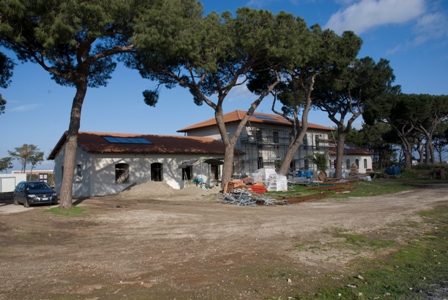Reconstruction of a Healthcare Facilty
Project location: Italy, Acilia (Rome)
Project start date: September 2009 -
Project end date: December 2009
Project number: 2009-22
Beneficiary: Piccoli Passi onlus
December 2009 Report
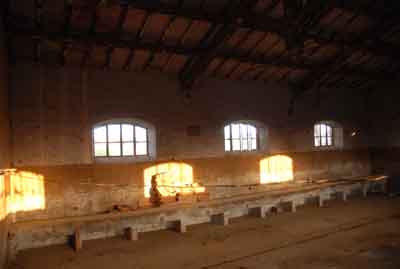
At the end of the primary tasks regarding masonry, we focused on the sidewalk realization, along the central cottage and the two former stables: we first did it to raise the walk floor level in order to avoid wetting and soil spurts on the vertical walls.
We first intervened to remove instable clods by diggers; then we created a neat line excavation 15cm thick, for about 200square meters area; formerly a 10x10cm, wire Ø 6, electrical welded grid was framing anchored by holes 80cm one each other and inserting iron bars. All together anchored by zincate wire.
Then we proceed with a cement cast, RCK300 dosed, for all the area involved (about 200sq)
After laying the reinforced concrete, we former laid a pier of sand and cement, by applying glue for have a bond coat between sand and cement.
The pier was mixed and laid by hands, stretched by aluminum strike-off board, with relative gradient towards outside. Finally we pave a walk floor in baked tiles 12x25cm, 45° sloping, by unfreezing stick, MAPEI blended, H40, then we plastered by tuck pointing by dry key in fine sand.
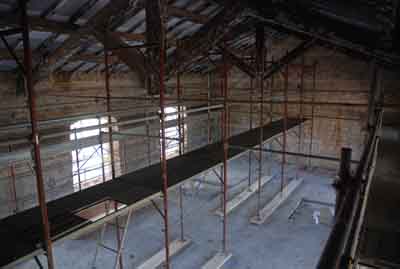
The vertical edge of the sidewalk as well is in bricks stuck vertically on the coast. Over the walk floor we realized 3 external entering stairs to access in 4 apartments at the raised floor.
The first job was to waterproof by 4cm thick roofing slate from outside to inside. Afterwards the air has been conveyed by PVC 120cm piping, for conditioning the previously built upstairs loft.
Then the rude half spaces have been built, in bricks and air bricks, with cement mortar bonding.
Finally we lay the cm4 peperino stones, fairly processed and cut in laboratory, polished and trimmed at the borders. This has been stuck with Mapei H40 glue, unfreezing and mortar bonding.
As well we did for the vertical under steps and the frontal welding, with the loft venting and former application of copper grids with internal net to avoid little bugs entry.
To avoid the raining rebound down on the wall, we realize a band, always in peperino tuff, 2cm thick, over 200 meters line, along the perimeter of the cottage and the two former stables.
The band height is over the backflow air holes level, each finished by n.24 air outlets in copper with external grid.
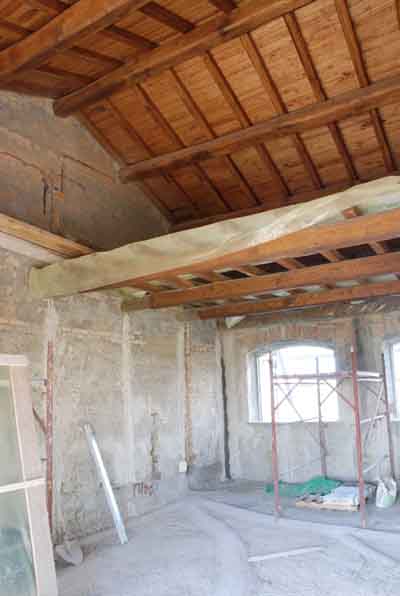
The entire job described, from the pier of clods to the finishing base-boarding, has been replayed in each former water tank room, at present a chapel.
The areas involved are about 30sqm. For a sensitive energy efficiency system (for fuel costs, residential heating and sanitary water heating), we projected to install an autonomous hot water circuit; the technologies nowadays allow us to produce hot water either in sunny days in summer time, either in winter and cloudy days, to inlet in the boiler preheated water, then less consumption of gas.
The heating plant is shared in 4 units, one for each apartment; each unit consists of 4 solar panels, of 2.5sqm each, fairly fastened on the south pitches, waterproofed with blanket insulation with lead coating (included in the equipment), along all the perimeter; finally we laid marsilian flat tiles cut along the slope of raining water.
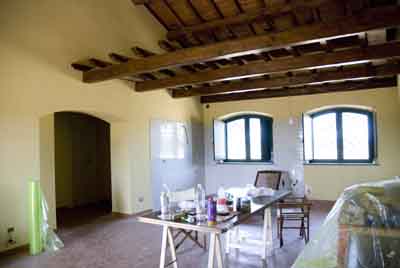
The solar panels outlet, that supply an higher temperature water in the closed circuit, is about 500l each unit, and is conveyed in 2 tanks. Each tank is set inside its apartment, in a specific lumber-room, built in bearing wall in poroton 30x25x25cm and girders IPE180cm, high resistance, because of the heavy weight in project; finale we laid a mass concrete cast, electro-welded grid, pier in sand and cement and paved in porcelain stoneware with MAPEI glue and filler.
The closed circuit plant, lead by a circulating pump and remote system exchange, is linked, each unit, to the main boiler. Each boiler is connected to a gas pipe that goes in an external safety box. The 4 safety valves (1 each boiler) are connected by an electric circuit with 4 independent cutout, 1 each apartment; the electric circuit feeds the residence by buried cable.
The line of the special FG7 cable is inserted in the central cottage internal alcove, at the ground floor, and from the alcove branches, through a cutout box, in a terminal board to feed the four units.
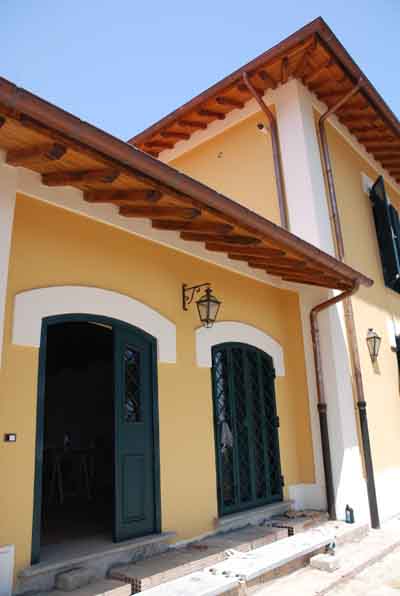
Each residential unit has a control board in a wall gain, cable troughs under the floor and in the walls under traces covered in cement mortar.
There are also 15 outlet boxes set in alcoves for the electrical line links, and each line for each outlet or spot has each dedicated cable trough. Each spot terminal has a terminal box "503" and/or "504" with B-Ticino brend, MATIX series power switches, adapter outlets and Siemens, changeover switches and break-before-make contacts.
Electric cables have different diameter: from 1.5mm^2 for the light spots, to 2.5mm^2 for the electric power, to 6mm^2 for feeding from the main frame to the single units. The electrical circuit is linked to the protective grounding by copper stake, and all the light spots are linked to it by cable (green-yellow) as far as the main terminal board.
The cutout box has 1 ground fault interrupter before, it has several magneto thermal multi aperture switches for: lighting, electrical power, kitchen, bathrooms, solar panel circuits, hot water and boilers.
The heating plant has a chronothermometer, that control internal temperature by sensors, and programs all day long the level of temperature weekly.
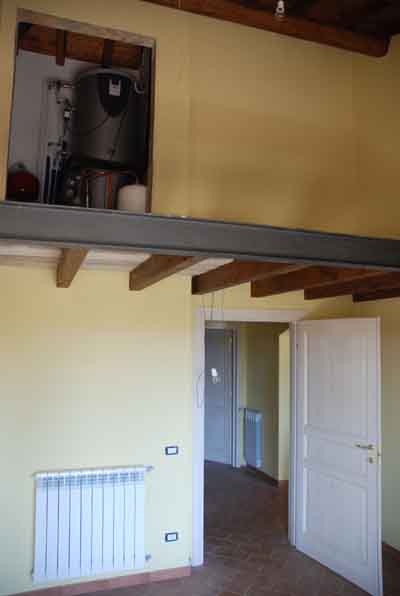
Lastly the plant included also the cottage external lighting, by 6 lamps, in wrought iron, wall anchored. There is a dedicated electric line for the intercommunicating system of each apartment, supplied by a lonely power station, tat the 4 apartments share, that allows to open the external pedestrian and for vehicles gates by electro switches; always by the same power station (for the intercommunicating and phone system) it is possible to communicate by phone among the apartments and the offices.
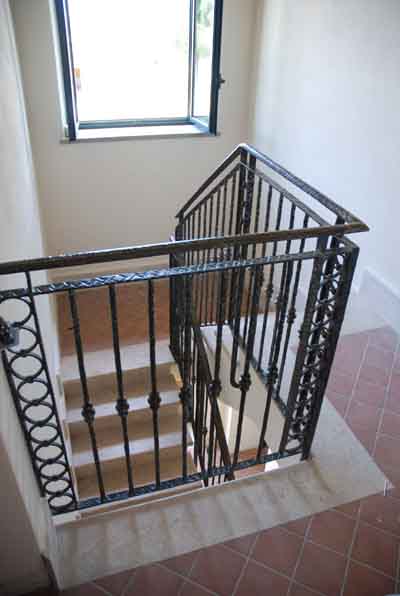
A single line supplies the chapel, for the external lighting, switches, socket, and internal light spots.
We left the space for a passage from a catch basin external to the cottage, for eventual future park lighting by lamps.
Finally the painting of all the cottage, boiler room, crape room, has been made in KERAKOLL bin shade. The choice of a biological line of finishing is for the wall transpiration ( from the plaster coat, to the bio-lime KERAKOLL line), then all the color shades must have the property of moisture-vapor transmission.
.jpg)
There is a first layer of "stabilizing", laid by rolls, then after it dried (about 24 hours) we laid an insulating layer -bonding by siloxanes. Even for it we wait for 24h, then we colored differently, always by siloxanes and moisture-vapor transmitter, twice.
The choice of colors is: ochre-mustard yellow for the flat walls, and dirty white for the bugnato stone bands, columns and the baseboard. For the interior the choice is for 5 colors: light pastels to be sober like the cottage is, but rich of light and exterior beauty; every color in contrast with the truss and sheeting in chestnut tree.
Same procedure was followed for the chapel room, for the exterior and interior surfaces.
June 2009 Report

From the main wells in fixed sections of about 60 cm width and varying depth; from the height of 0,80 m for the current and internal phone plant, up to the height of 1,60 m for the gas and running water system. A 30 cm foundation of pozzolana has been set in order to avoid the flowering of roots or any kind of vegetation.
Then we laid on the pozzolana foundation the pleated cables ( cavi corrugati ) divided according to the different utilities (consumptions) and in different colors (blue and red). As recommended by the suppliers of the different utilities, we constructed a few concrete wells below the height of the digging (40×40 cm) and there extensions to reach the ground quote.
This extra work has been done to diminish the excess length of the cabling and to facilitate the setting of the wires. The different wells are located at no more of 50 m one from the other, the corrugati elements were cut at the edge of the internal wall of the well and subsequently cemented and sealed. Before placing the cables we prepared a drying foundation for each well made of crushed stones and gravel. Once the excavation was ready and open, we set the various elements at the very bottom then placed the 4 polyethylene pipes for the gas, one for each of the 4 apartments. At the same time the cable for the internal telephone was laid; the cable has the right measurement and section to guarantee functionality from the gate in front of the street to power board and from there up to the 4 single apartments.
Once the excavation was ready and open, we set the various elements at the very bottom then placed the 4 polyethylene pipes for the gas, one for each of the 4 apartments. At the same time the cable for the internal telephone was laid; the cable has the right measurement and section to guarantee functionality from the gate in front of the street to power board and from there up to the 4 single apartments.
In order to place the electric cable we decided to choose a high section wire of 2 mm (fig. 7) stretched in one section from the supplier's wells to the internal subdivision of the 4 apartments. The drinkable water pipe, the only one placed inside the masonry shaft was also set inside the corrugati and led on the pozzolana foundation. At the bottom of the excavation was also placed the telephone cables slot. We subsequently prepared the various pleated cables ( corrugati ) to allow the connection by the supplier (Telecom).
When all the cables were properly set and laid we covered everything up with absolute pozzolana at the whole height of the corrugati plus 30 cm. The pozzolana was wet and turned compact by stamping in order to avoid land slide, cracks or fissures. The excavation was then filled again using both mechanical and human work. Each material was pressed, wetted and made compact using the scraper (bulldozer), the crawlers and finished up by the workers. The extensions of the concrete wells were cut up to the level and made even, covered with cement and/or cast iron caps. In doing so we could close the work inside completely and at the same time made possible any inspection and periodical servicing. When all concerning the lay underground works finished we started to build the masonry niches for each plant and the shutters.  We had to work on one and more excavations to set one and more foundations (3) to construct the different niches. The measurements were 60×200 cm, 30 cm depth for a number of 3. We built 3 cages with reinforcing iron rods of an adequate section made of correnti of 16 cm diameter and square bent brackets (iron section 8 cm) laid at 20 cm one from the other. The cages, tied at the junctions with carpentry metallic thread, were laid at the bottom of the excavation, leveled and anchored to the walls of the excavation with metallic binding. The underground work completed we filled the excavation and cages up with high resistant concrete RCK300 (6 days to harden). Once the level was cemented and ready we started constructing the 3 niches: 1 for the main water pipe cm 60×100×100 height; 1 for the 4 gas pipes cm 60×200×100 height and one for the internal supplying of all consumptions placed in front of the house cm 60×200×100 height. All the 3 niches have the same shape and finishing. The following step was the vertical construction of as stone work (cm 60) up to the baseboard, to lateral sides and a basement. All the internal and external surfaces were plastered with sand and cement.
We had to work on one and more excavations to set one and more foundations (3) to construct the different niches. The measurements were 60×200 cm, 30 cm depth for a number of 3. We built 3 cages with reinforcing iron rods of an adequate section made of correnti of 16 cm diameter and square bent brackets (iron section 8 cm) laid at 20 cm one from the other. The cages, tied at the junctions with carpentry metallic thread, were laid at the bottom of the excavation, leveled and anchored to the walls of the excavation with metallic binding. The underground work completed we filled the excavation and cages up with high resistant concrete RCK300 (6 days to harden). Once the level was cemented and ready we started constructing the 3 niches: 1 for the main water pipe cm 60×100×100 height; 1 for the 4 gas pipes cm 60×200×100 height and one for the internal supplying of all consumptions placed in front of the house cm 60×200×100 height. All the 3 niches have the same shape and finishing. The following step was the vertical construction of as stone work (cm 60) up to the baseboard, to lateral sides and a basement. All the internal and external surfaces were plastered with sand and cement. 

The front of the building at the first stage of the restructuration
